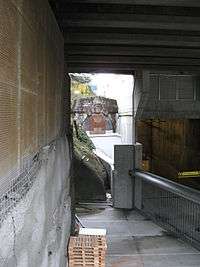Dunsmuir Tunnel
The Dunsmuir Tunnel is a subway tunnel below Dunsmuir Street in Vancouver, British Columbia, Canada. The tunnel is used by the Expo Line of Metro Vancouver's SkyTrain rapid transit system. It is located downtown and has Burrard and Granville stations built within the tunnel. The western tunnel portal is located midway between Waterfront and Burrard stations, while the eastern portal is adjacent to Stadium–Chinatown station.
Westbound SkyTrain platform at Granville station | |
| Overview | |
|---|---|
| Location | Vancouver, British Columbia |
| Coordinates | 49.282981°N 123.115420°W |
| Start | Waterfront |
| End | Stadium–Chinatown |
| No. of stations | 2 |
| Operation | |
| Work begun | 1931 |
| Opened | July 16, 1933 |
| Reopened | December 11, 1985 |
| Owner | TransLink |
| Traffic | Automated guideway transit |
| Technical | |
| Length | 1,396 metres (4,580 ft) |
| No. of tracks | 2 |
| Electrified | Third rail |
History
The tunnel was originally built by the Northern Construction Company in 1932 connecting the Canadian Pacific Railway railyards on Burrard Inlet and False Creek at a cost of $1.6 million. The tunnel's original east portal was located further south than the current portal, easing trains into the False Creek yards on a gentle southward curve. It was clearly visible until about 2005, where it was almost completely hidden next to an outdoor storage area behind the Costco. The original portal was destroyed in 2011 to make way for a new development, but there remains an abandoned section of tunnel, unused by SkyTrain.[1][2][3]
The tunnel was taken over by BC Transit in the early 1980s when the SkyTrain system was built in conjunction with Expo 86. Because the tunnel is only wide enough to accommodate a single railway track but with sufficiently high clearance, a superstructure was built inside the tunnel to carry the westbound SkyTrain track above the eastbound track. This results in the two stations within the tunnel having a split platform configuration.
See also
References
- "The SkyTrain Tunnel - The History of Metropolitan Vancouver". vancouverhistory.ca. Retrieved 17 February 2014.
- "Happy 80th Birthday to the CPR Dunsmuir Tunnel, Vancouver, BC ..." flickr.com. Retrieved 17 February 2014.
- Bollwitt, Rebecca. "Tunnels Under Downtown: Vancouver History Readers' Choice". miss604.com. Retrieved 17 February 2014.
